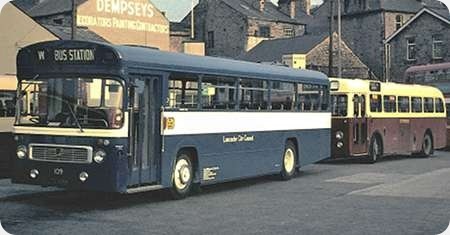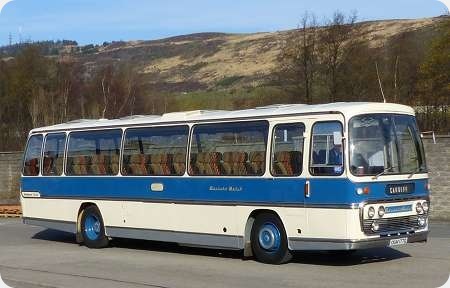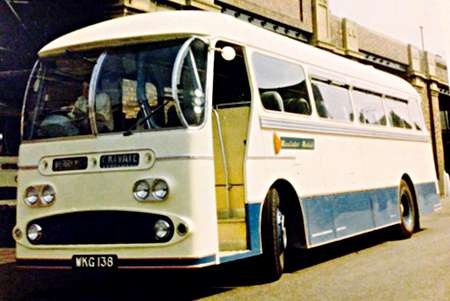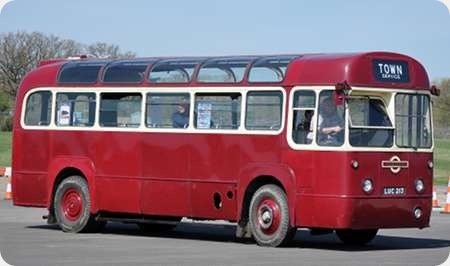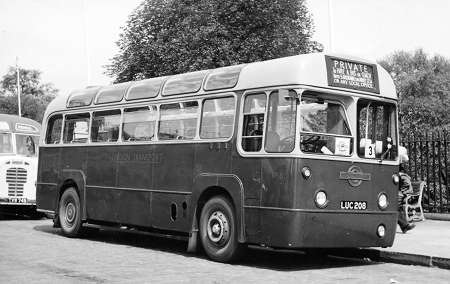Lancaster City Transport – Leyland Panther – LTC 109F – 109
Lancaster City Transport
1968
Leyland Panther PSUR1/1R
East Lancs B53F
LTC 109F fleet number 109 is a Leyland Panther PSUR1/1R with East Lancs B53F body, new to Lancaster in 1968. The batch was in maroon and cream livery then, but we see it in ‘post merger’ livery of blue and white, on the sunny evening of 20 May 1975. The scene is Lancaster’s Damside Street Bus Station. 389 JTD a 1959 Tiger Cub is behind, still in the old livery but with the Tilling style of fleetname adopted as an interim measure for Lancaster and Morecambe & Heysham vehicles, together with what looks like another Panther on the extreme left of the view.
Photograph and Copy contributed by Pete Davies
24/04/16 – 09:09
In late 1979 LTC 109F came to Derbyshire when, in company with Morecambe and Heysham AEC Swift UTJ 908H, it joined Woolliscroft Silver Service fleet at Darley Dale. Initially they were on loan from Lancaster City but were purchased outright soon after arrival. The Panther bore a strong family resemblance to a batch of Neepsend bodied Panthers at nearby Chesterfield, these Neepsend bodies being built under license from East Lancs. LTC 109F lasted a couple of years but was eventually stripped for spares and the remains had been scrapped by 1982. The Swift lasted a little longer going to North at Sherburn in 1983.
David Hargraves
24/04/16 – 10:43
My original slide includes the Ribble PD3 with Metropolitan Cammell body which some members may have spotted on the extreme right It is from the PCK series. Lancaster had six of these Panthers, in two trios: GTC 104-106F from 1967 and 107-109F from 1968.
David comments on a number of supposed ‘East Lancs’ products being bodied by Neepsend. Some of Southampton’s later Regent V fleet were products of this arrangement and I think I’ve read somewhere that many think Neepsend was a subsidiary of East Lancs, but they were in fact part of the same group. Wrong again, Davies?
Pete Davies
24/04/16 – 12:42
Just a clarification re. Pete’s comment, the registrations of the second batch of three Panthers were LTC-F.
Lancaster reverted to Leopards for its next deliveries.
Dave Towers
24/04/16 – 18:33
Thanks, Dave. I must fire my proof reader!
Pete Davies
26/04/16 – 14:57
East Lancs were owned at the time by John Brown engineering who were based originally in Sheffield They re activated bus building in Sheffield at a factory on Neepsend Lane using East Lancs designs.
So really Neepsend were never an East Lancs subsidiary but both were part of the John Brown empire.
Sheffield took some rear engine chassis from them in 1964/65 The firm (I think) built one more body on a Bedford VAS chassis for Sheffield but by this time it was called Cravens Homalloy.
Chris Hough
27/04/16 – 05:54
Thanks, Chris. I’m glad that the old grey cells have not failed me this time.
Pete Davies
Quick links to the - Comments Page - Contact Page - Home Page
